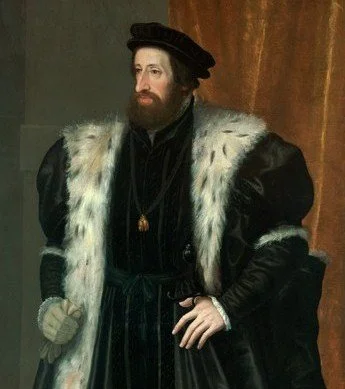After the death of Louie II, the Kingdom of Bohemia needed a new king, of which Ferdinand I took up the mantle. As the King of Bohemia, he inherited many issues surrounding the kingdom, including the encroaching Ottoman Empire, the political tug of war between the Bohemian diet members, and the religious strife between Protestants and Catholics. During his time, Ferdinand I delicately wielded his influence and power as the King of Bohemia, eventually becoming the Holy Roman Emperor.
History of Karlštejn
Karlštejn Castle was built by Bohemian King and Holy Roman Emperor Charles IV to house holy relics and the crowns of the kingdom and empire. Karlštejn Castle consists of three different levels, those being the Imperial Palace, the Marian Tower, and the Great Tower. Throughout the castle, Karlštejn housed many jewels and precious stones, symbols of royal authority and legitimate monarchy. Karlštejn Castle remains a cultural, historical, and architectural icon in central Europe and the Czech Republic.
The Hussite Reformation: The Council and Trial of Jan Hus
Following his continued preachings of reform and his various excommunications, Jan Hus was called by Holy Roman Emperor Sigismund to come to the Council of Constance as part of his plan to resolve the issue centered around Czech heresy. The Council of Constance, which was convened in 1414 to solve the Western Schism, succeeded in its goal of doing just that. However, the council’s handling of Jan Hus and his growing Hussite following would prove far from successful. Imprisoned and put on trial, Jan Hus’s fate was in the hands of those who would make a disastrous mistake in the long run and unleash war in Bohemia.
The Hussite Reformation: Life of Jan Hus and the Church
In 1414, a Czech theologian named Jan Hus was called before the Council of Constance for heresy against the Catholic Church and Pope. Jan Hus had preached about the need to reform the corruption within the Church, desiring to adhere more to a more communal Christianity that he believed the New Testament spoke of, and for that he had been excommunicated numerous times. His life up to this point set the groundwork for the eventual history of the Catholic Church and the Holy Roman Empire to change forever.
Mordecai Maisel: Jewish Influence in Prague
Mordechai Ben Šemuel Maisel was a businessman, philanthropist, Jewish community head, and builder of Prague’s Jewish town during the late 16th and early 17th centuries. He established a successful banking business and several silver and gold mines in Bohemia. Maisel’s financial success was instrumental to the tactical success of the Holy Roman Emperor’s forces during the Turkish Wars, which allowed him more financial freedoms and decisions that made him wealthier.
Charles IV: King of Bohemia and the "Romans"
Charles IV’s efforts helped to elevate the city of Prague to new heights, establishing it as the intellectual and cultural center of Central Europe. Yet, his reign was marked by political disagreements and failures to centralize the government. One major, yet brief, threat to Charles IV’s authority came from Louis IV, the excommunicated emperor Charles IV replaced. Another major aspect of Charles IV’s authority was the elevation of Prague as a major player on the world stage for centuries to come.
St Wenceslas, Patron Saint of Bohemia
St Wenceslas Day, which honors Duke of Bohemia Wenceslas I, is celebrated on September 28th in the Czech Republic. His story begins with his Christian grandmother Ludmila, having been raised by her up to the time Wenceslas I's mother, Drahomira, had Ludmila assassinated to become Queen Regent. After regaining the throne from his mother, Wenceslas continued to reign for 14 years until his death.
Charles IV and the New Town
For his time in the 14th century, King of Bohemia Charles IV was one of the most progressive rulers in his time. His greatest contribution to Czech culture is his urban plan for Prague, entitled New Town, or Nové Město. He centered the people of the town in his plans and centralized the working class members of society into New Town, which made it a hub for business and merchant activity. His establishment of Charles University also brought about many major institutional changes throughout Bohemia’s history.
Emperor Rudolf II: Prague's Patron of Arts and Science
Rudolf II, leader of the Holy Roman Empire, ruled from 1575-1612. His reign as emperor was nontraditional and he was well known for his patronage of arts and science. Under his rule, alchemists were protected and allowed to experiment and learn, making Prague one of the cultural centers of this scientific discipline. His rule also allowed artists from all over Europe to thrive and flourish, which artists noticed and greatly appreciated.
The Mystery of the Voynich Manuscript
In 1912, a strange manuscript surfaced in the collection of an antique-bookseller. It is written in a language that is not found anywhere else, contains pictures of plants that can not be identified, and astrological charts that don't match any records. The text today is known as the Voynich Manuscript, and it has been called one of the most mysterious books in the world.
Prague's St. Vitus Cathedral
Prague Castle is one of the biggest tourist attractions in the city. This complex is the largest in the world, and people from around the world visit to marvel at the site. Inside the castle complex lies St. Vitus Cathedral, the biggest cathedral in the Czech Republic and a wonder of Gothic architecture.











